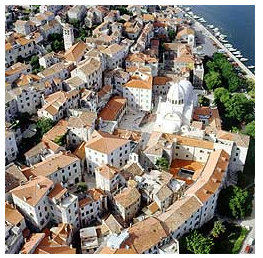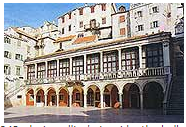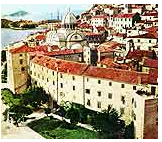The Zadar-Sibenik region is situated in a national park ring. The Plitvice and Paklenica national parks in the north and Krka National Park in the northeast surround the region, and on the coastal side the region is enclosed by Kornati National Park and the Telascica nature park. The distinctive Vransko Lake is situated between Zadar and Sibenik and is abundant in fish while numerous wading birds reign the shoreline.
Completeness of the historical core
Below the fortress (castrum), on a stony rise in the area between today’s double city walls in Dolac and the cathedral, the first urban habitat emerged. It is the IX century Šibenik, mentioned in documents of Croatian kings.
The city area defined by the city wall perimeter in XIV century started to grow in population density during the time of communal free development (1358-1409).
In the XVI century construction, led by Juraj Dalmatinac and the renaissance builder Nikola Firentinac, started to develop. Wood exploitation in the construction industry had been limited by statutory resolutions and more and more stone was being used. Beside the grand cathedral rose other churches, palaces, streets and town squares.
In the XVI century Šibenik received a defined urbanism plan. From 1540 to 1650 the building of the three fortresses – St Nikola, St Ivan and Šubićevac strengthened Šibenik’s fortification system.
The Baroque (XVII and XVIII) did not significantly influence the city structure, though it did leave traces in sacral and other buildings. Under the Austrian government in XIX ct a part of the city walls got torn down. However the wholeness of the old urban agglomeration has been preserved. It consists of three parts: Grad, Dolac and Gorica.
Town

The historical town centre can be accessed from all sides. The main entrance is the one from Poljan and it represents the central area of the total Šibenik agglomeration. The main city door stood on Poljana’s southwest side up to 1864. On the left side of the entrance there are the remains of the city walls with the sculpture of St Mihovil, the city’s patron
There is also a neorenaissance theatre building opened for public form 1870. In this largest part of the city centre there are several areas of various sizes that reflect a peculiar unity of ambient values and living areas ( Trg Ivana Pavla II, Dobric, Square of the Croatian Republic etc.). The palaces of local noblemen0 stand out in Šibenik’s urban architecture. The central Town Square , the square of the Croatian Republic , former Plahtea communis, has been the heart of medieval Šibenik’s public and social life. Its planning and construction was finished in XVI ct. Some of the finest examples of Šibenik’s architecture can be seen around the square; the cathedral, the City Hall, the Little Loggia, Bishop’s and City Prince’s palaces as well as the stone palaces of influential citizens.
City/Town Hall

The Town Hall is situated on the central town square, former Plathea communis. It is a very s harmonious and spacious renaissance building erected between 1533 and 1536. On the ground floor there is a portico with semicircle arches that used to lead to former communal management offices. A remarkable hall, in which city councils used to gather, is situated on the first floor. In December 1943, during allies’ air raids, the hall was completely demolished. After the war it was restored to its original form and appearance with the interior furnished and organized according to its function today.
Duke’s palace

Venetian highest ranking official in the commune; city prince-captain lived and ruled from this, originally much greater, building. Today only two wings are preserved. In the south wing’s central area there is a gothic gateway with the city door. On the west wing, facing the cathedral’s sacristy, are two simple stone rimmed doors. In 1975 the adaptation of Kneževa palace into Museum of the city of Šibenik was completed.
Dolac and Gorica
Urban complexes Dolac and Gorica originated on the steepest part of the rise, on the city’s western side. Narrow and winding streets with numerous stairs are common for these parts of the city. St Cross church, built in 1605-1608, dominates the Dolac area. Attendance to this church increased since the crucifix (which, as the story goes, sailed down the river Krka) was erected. In Dolac coastal area there is a grand architectural complex, forme female Benedictine monastery of St Katarina (Kvartir). Under the French government nuns had to leave the convict which French military authorities then took for their own use. Today this cultural and historical monument is a stambeni object.
THE CHURCH OF ST. DONATUS
(9th century), a symbol of the city of Zadar.
NIN
Nin is the oldest Croatian royal town. An exceptional type of city-church complex, it is unique in the entire Mediterranean region. Small, isolated “places of worship” are witnesses of the oldest Croatian culture from the 10 th and 11 th centuries.
PAKLENICA NATIONAL PARK
The National Park Paklenica is a unique geographical and climatic region. This is an area where the mild Mediterranean and harsh mountain climates meet. It is also an area of the amazing symbiosis of the sea and the mountains. A walk on park paths and the view of magnificent rocky grounds and the crystal clean sea provide an unforgettable experience.
The Paklenica National Park Board, Tel: 023/369-202
KRKA NATIONAL PARK
The Krka National Park has seven impressive waterfalls, out of which Skradinski Buk is the most magnificent.
Krka National Park Board, Tel: 022/217-720
KORNATI NATIONAL PARK
Spread out over an area of 300 sq. km, with about 140 large and small islands and cliffs and a total land area of 69 sq. km, the Kornati island group is unique in the whole Mediterranean. Peasant and fishing huts are scattered along gentle and well-protected bays of the surrounding islands (Zut, Ist, Kornat, etc.).
Today they are a favorite destination for seafarers and tourists who enjoy a private and active vacation. The natural beauty of the Kornati Islands is famous throughout the world.
The Kornati National Park Board, Tel: 022/434-662
